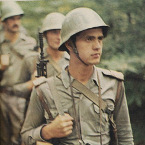nikolas93TS
Posts: 619
Joined: 2/24/2017
Status: offline

|
In general, using steel equivalency is a fairly inefficient way of presenting armor, as the interaction between each armor type and penetrator type are unique, and trying to shoehorn the provided protection into one single value against all different types of penetrators (both kinetic and chemical) is flawed. However, it is obvious that we are war-gaming here and we have dozens of advanced tank variants and it is simply impossible to model them that accurately in a game such is Armored Brigade.
In simplest terms, ERA works by degrading the penetrator and hence reducing its overall penetration. For example British ROMOR-A is rated at up to 95% reduction against a 127mm charge. Blazer used a rather primitive construction using one reactive element per tile. Each reactive element consisted of a 3mm steel plate, a 3mm thick layer of explosives and a further 3mm thick steel plate. It could reduce the penetration of a basic RPG-7 projectile from 300mm to about 100mm into residual steel, although the absolute figures are depending on the angle of impact.
In game terms, that translates in about 200mm increase (according to another source, up to 240mm) to CE protection, which is added to base armor. Since Blazer is useless against KE or tandem penetrators, those values remain the same as on base tank. Coverage is not modeled in AB because there are way too many variables, and statistically the chance of hitting the same spot in combat is so low that we omitted that as well (and there is also a "weak-spot" chance).
|
 Printable Version
Printable Version






 New Messages
New Messages No New Messages
No New Messages Hot Topic w/ New Messages
Hot Topic w/ New Messages Hot Topic w/o New Messages
Hot Topic w/o New Messages Locked w/ New Messages
Locked w/ New Messages Locked w/o New Messages
Locked w/o New Messages Post New Thread
Post New Thread